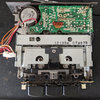Hi everyone, first post here.
I have a mid 90's Camaro, and I want to keep a working original radio/CD/tape player in the car. I have a couple of units, one with a cd, one with a cassette. I've had a ton of trouble finding any real information about these. No schematics, repair manuals, or really much "talk" online about fixing these. Seems that stuff from the 80's and before is somewhat better documented.
For the cassette, the radio/displays/buttons work, but the tape player doesn't play. I don't know who made these, but it's not the Blaupunkt units seen in the 80's Delcos. You insert a tape, and it doesn't run the tape forward at all. I don't think fast forward or reverse properly work, and usually the unit clicks constantly from a solenoid. Something to do with the auto reverse?
The CD unit has a problem where the display randomly flickers on and off. It's completely random, and sometimes is a quick flash, other times much longer. Also, the CD unit rarely plays. It whirs and tries to read, but usually comes up with an ERR message. These CD units were made by Technics, but I can't find any real information about them except some people mentioning replacing caps to fix them...with no other details.
I would really appreciate any help with this, or at least pointing me in the right direction to ask somewhere else about fixing these units. I can take more pictures if it helps.









I have a mid 90's Camaro, and I want to keep a working original radio/CD/tape player in the car. I have a couple of units, one with a cd, one with a cassette. I've had a ton of trouble finding any real information about these. No schematics, repair manuals, or really much "talk" online about fixing these. Seems that stuff from the 80's and before is somewhat better documented.
For the cassette, the radio/displays/buttons work, but the tape player doesn't play. I don't know who made these, but it's not the Blaupunkt units seen in the 80's Delcos. You insert a tape, and it doesn't run the tape forward at all. I don't think fast forward or reverse properly work, and usually the unit clicks constantly from a solenoid. Something to do with the auto reverse?
The CD unit has a problem where the display randomly flickers on and off. It's completely random, and sometimes is a quick flash, other times much longer. Also, the CD unit rarely plays. It whirs and tries to read, but usually comes up with an ERR message. These CD units were made by Technics, but I can't find any real information about them except some people mentioning replacing caps to fix them...with no other details.
I would really appreciate any help with this, or at least pointing me in the right direction to ask somewhere else about fixing these units. I can take more pictures if it helps.








Last edited:





